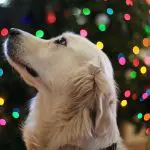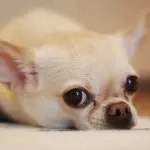Siberian Husky
Description:
The Siberian Husky (shortened to Sibe or Siberian but not Husky) is a very handsome medium to large dog breed. This Spitz-type dog has a friendly wolf-like appearance with a strong body that is built for endurance. The head is medium-sized and round on top with: a wolf-like face, almond-shaped and oblique set eyes; and triangular ears set high and close together. The eyes can be blue or brown or surprisingly one of each color and the ears are well furred on the inside as well as the outside. The Siberian has a deep chest, level back and a furry tail that is carried upright when the dog is alert. Siberians have natural ears and tail. The Sibe has a straight, soft, medium length outer coat with a dense undercoat. All colors are permitted but grey, red, silver and black with white markings are very common. Male Siberians stand 21 to 23.5 inches tall and females 20 to 22 inches tall at shoulder height. Female Sibes
can weigh from 35 to 50 pounds and males from 45 to 60 pounds which just exceeds our range for medium-sized dog breeds (25 to 50 pounds).
Siberian Huskies are members of the American Kennel Club (AKC) Working Dog Group.
Siberian Husky Pictures:
History:
The Siberian Husky breed was developed by the Chukchi, a nomadic Inuit people of Eastern Siberia, for pulling sleds over long distances. Siberians were the ideal working dogs for the harsh Siberian winter climate and terrain. The Chukchis were quite isolated and were able to retain the purity of the bloodline over several centuries after development. At the beginning of the 20th century, fur traders brought the Siberians to North America where this breed excelled at competitive dog sled racing. Siberians won most of the endurance racing titles starting in Alaska in 1909. The rugged Alaskan terrain was ideally suited for the lighter Siberian Huskies. The Siberians became very popular after a number of teams of sled dogs were used in relays to deliver antitoxins to Nome, Alaska to combat a diphtheria epidemic. The AKC officially recognized the breed in 1930 and Siberians have become popular companion
dogs. A 2006 movie Called “Eight Below” is a true story starring a team of Siberian Huskies that were stranded in Antarctica. There is some concern that this will result in unscrupulous breeders exploiting the breed’s new found popularity. The Siberian was ranked 25th out of 154 dog breeds registered by the AKC in 2005.
Temperament:
The Siberian Husky is playful, good natured, friendly, gentle, athletic and independent and makes a good companion dog. Siberians get along well with older children but are not recommended for toddlers and small children unless raised with them from a puppy. However the Siberian is not a breed for everyone. Too many people are attracted to this handsome dog without realizing this is a working sled dog that needs a lot of physical activity. Siberians belong outside in an escape-proof large yard but get bored very easily if they have too little exercise. A bored Siberian can be nervous and destructive. Most Siberians are friendly with everyone and enjoy the company of other dogs. However many Sibes have a high prey drive and should be securely fenced or they will chase neighbours cats, chicken and livestock. Training Siberians is difficult and takes a lot of time and patience. Food reward-based training works best
but owners must be firm and consistent or the Siberian will assume the alpha role. Training must be started when the Sibes are puppies and continued through to adulthood. Siberians don’t bark much (although they howl from time to time) and are too friendly to make good watchdogs. Siberians do best with an experienced owner.
Exercise:
Siberians need lots of exercise beyond a daily long walk. They need to be able to romp and run in a large fenced area. This is not an apartment dog. The Sibe should be taken running, hiking, and/or biking as often as possible but always on-leash because of their high prey drive. Siberians enjoy cool weather but will adapt to most climatic conditions.
Grooming:
Siberians only need a weekly brushing most of the year. However twice a year, in the spring and the fall, the Sibe will blow its coat. At these times you will need to brush these dogs twice per day and you won’t believe the amount of hair these dogs will shed. It will come out in clumps and handfuls and you could stuff a mattress with all the hair. Eventually the breed will stop shedding and go back to being a dog that requires minimal grooming.
Health Issues:
Siberian Huskies have a life expectancy of 12 to 14 years and are a generally healthy and hardy breed. There is some hip dysplasia in the bloodlines but it is not too prevalent at this time. The common genetic health problems seem to be associated with eye disorders including juvenile cataracts, corneal dystrophy and progressive retinal atrophy. Information on these genetic diseases can be found in our article Hereditary Diseases in Dogs. Prospective buyers should ask for the breeding parents Orthopedic Foundation for Animals (OFA) test results for hip dysplasia and also the Canine Eye Registry (CERF) recent ophthalmologists report for eye
disorders.
Article type: xdogbreed


